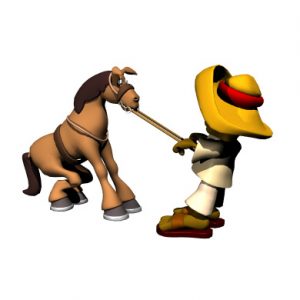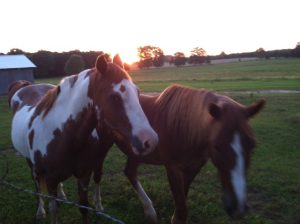 The young horses tend to gather at the northeast corner of the pasture each afternoon. There, they tease each other, chase each other, and just generally enjoy each other’s fellowship.
The young horses tend to gather at the northeast corner of the pasture each afternoon. There, they tease each other, chase each other, and just generally enjoy each other’s fellowship.
One afternoon, the conversation drifted to discussing The Master’s expectations. Archie, the 2-year-old stud colt, pricked his ears at this topic. Although Archie had spent time with The Master, his real training was just beginning.
Cinch, the young roan, believed himself an expert on all things related to The Master. After all, he had been trailered to rodeos and trail rides more than any of the other young horses.
“I’ll tell you one thing,” said Cinch, “when Master leads you through the pasture gate, he expects you to promptly spin your hindquarters to the left.”
“That’s for sure!” enjoined Sonny, the handsome paint horse. “That took me a while to figure out. I used to sometimes get hung up halfway through the gate and just stand there wondering what to do. It took me a while to figure out I was supposed to walk past Master, through the gate, swinging my hindquarters to the left. I finally got it figured out, though.”
“Same here!” laughed Cinch. “Boy did I feel stupid standing there looking at The Master, wondering what to do. You don’t want to make that mistake, Archie! Take my word for it. Every time Master leads you through the pasture gate, always promptly spin your hindquarters left. Then, as Master closes the gate take one step back. As Master leaves the gate, take another step back followed by a right shoulder turn as you fall in step behind him. The smoother you learn to do all that, the better Master likes it.”
“Wow! That’s a lot to remember,” sighed Archie, as he contemplated the shame of getting hung up not knowing what to do.
“What if Master leads out the other pasture gate?” queried Buck, the little buckskin the Master’s grandchildren loved to ride.
“What are you talking about?” Cinch’s eyes narrowed and his ears swiveled back as though he’d just been challenged.
“I’m talking about that gate at the shed,” answered Buck, ignoring Cinch’s agitation. “That gate swings the other direction, and Master expects a right hindquarter swing as you come through.”
“That’s true!” agreed Knockout, the young sorrel who’d spent so much time riding the gravel roads with Master, in recent months. “On right-hinged gates, Master generally asks for a left hindquarter turn and on left-hinged gates he generally asks for a right hindquarter turn. It all depends on the situation.”
“Oh my!” muttered Archie in wide-eyed wonder as he recited the growing list of rules, “Right-hinged left spin. Left-hinged right spin. Then two steps back and follow through with an opposite-direction shoulder turn.”
“Exactly!” Buck confirmed.
“Guys! Guys! You’re going to confuse the poor kid,” admonished Cinch. “Can’t you see he’s feeling overwhelmed? He can’t learn all the rules in one afternoon. Master doesn’t use the shed gate often, anyway. Let the poor kid focus on learning the rules for the main gate he’ll be using most of the time, anyway.”
“But,” responded Buck, “If he only learns half a rule, he’ll be even more confused when he encounters an exception. He needs to learn all the rules and all the exception clauses, or he’ll be lost.”
“Look,” countered Cinch, “I’m just saying it’s best to focus first on the normal expectations then let him figure out the exceptions later. We haven’t even got him out the pasture gate yet, and you’re already confusing him. There’s a ton of other things he needs to learn. Like, when Master takes you off property always turn right at the end of the driveway.”
“That’s for sure!” Sonny affirmed. “You may as well get that down right now, and save yourself a lot of trouble later. End of the driveway always means a right turn.”
“One time, Master and I spent two hours circling the end of the driveway while I figured that one out,” chuckled Knockout.
“Except, one time Master took me left at the end of the driveway,” countered Buck.
Cinch swiveled to face Buck, ears pinned and nostrils dilated, “No way! That rule never changes. It’s always right at the end of the driveway. No exceptions!”
“I’m telling you,” Buck responded, “one time Master took me left, all the way to the blacktop highway, before he turned around and brought me back.”
Cinch glared indignantly at Buck, “No way! Master would never do that! It sounds to me like you’ve been listening to the wrong master, Buck.”
“I know The Master, and I know where he led me. He went with me every step of the way,” Buck persisted.
“It’s true Cinch,” Knockout came to Buck’s defense. “Every once in a while, Master will take me left at the driveway, too. I think he does it on purpose just to make sure I’m paying attention and listening to him. He seems to like changing things up from time to time. In fact, I’m not even sure we’re going about this discussion from the right perspective. It seems to me Master is more concerned with my knowing how to respond to his cues.”
Facing Archie, Knockout continued, “Kid, the important rules to remember are Master’s cues. When Master squeezes your sides, move forward. When Master presses your left side move right. When Master presses your right side move left. When Master pulls on the bit, stop and back up. Those are the important rules.”
Wide-eyed, Archie recited the rules back, “Left side, right. Right side, left. Both sides, forward. Pull, stop. Wow! How will I ever remember all these rules and exceptions?”
A deep chuckle interrupted the discussion as the young horses turned to see LaDoux had approached unnoticed. LaDoux, the sorrel gelding with white spots either side of his withers, was the oldest and wisest horse in the pasture. “You youngsters have a lot to learn! Cinch, Knockout is much nearer the truth than you. It’s not about learning a bunch of rules and exceptions. It’s about listening to The Master and responding to his cues.”
As Knockout lifted his head and preened his ears forward in pride, LaDoux continued, “But that’s not the most important thing either, because cues sometimes change. Master likes to teach softer cues as we become ready to learn them, and sometimes new cues are required as we mature into new jobs.”
“Archie,” LaDoux continued gently, “There are only two rules that really matter. The first rule is to trust Master. Really, really trust him, knowing you can do whatever he asks without worrying about anything. The second rule is to watch out for other horses and treat each other with respect. That’s all you really need to remember. Master will teach you everything else you need to know. In fact, when you forget these two main rules, Master will remind you of those as well. Trust Master to teach you all you need to know and quit worrying about memorizing rules and exception clauses.”
On hearing this sage advice, Archie breathed a sigh of relief, felt his tense muscles relax, and sensed his worried emotions calm in renewed trust that Master will always care for him.
One of them, a lawyer, asked Him a question, testing Him, “Teacher, which is the great commandment in the Law?” And He said to him, “‘You shall love the Lord your God with all your heart, and with all your soul, and with all your mind.’ This is the great and foremost commandment. The second is like it, ‘You shall love your neighbor as yourself.’ On these two commandments depend the whole Law and the Prophets. (Matthew 22:35-40)
But as many as received Him, to them He gave the right to become children of God, even to those who believe in His name, who were born, not of blood nor of the will of the flesh nor of the will of man, but of God. (John 1:12-13)
A new commandment I give to you, that you love one another, even as I have loved you, that you also love one another. By this all men will know that you are My disciples, if you have love for one another. (John 13:34-35)
Your thoughts?
Like this:
Like Loading...


 She graciously steered the conversation toward a topic she knew I like, “So, how do you make a horse go?”
She graciously steered the conversation toward a topic she knew I like, “So, how do you make a horse go?”

 I’m not an expert horse trainer. I am, at best, a novice horseman…maybe more of a wannabe horseman…which is okay, too. My only horse experience has been working with our own horses. So, take my observations with a grain of salt…I have a fairly narrow experience spectrum in regard to horse behavior.
I’m not an expert horse trainer. I am, at best, a novice horseman…maybe more of a wannabe horseman…which is okay, too. My only horse experience has been working with our own horses. So, take my observations with a grain of salt…I have a fairly narrow experience spectrum in regard to horse behavior. Halter in hand, I walk through the pasture gate and approach my horse. He looks up from grazing, facing me, expectantly. As I approach, I walk toward his shoulder rather than his face…horses sometimes seem intimidated by a direct face-to-face approach…and I want my approach to be welcomed. They’re prey animals…programmed by the Creator to be sensitive to such things.
Halter in hand, I walk through the pasture gate and approach my horse. He looks up from grazing, facing me, expectantly. As I approach, I walk toward his shoulder rather than his face…horses sometimes seem intimidated by a direct face-to-face approach…and I want my approach to be welcomed. They’re prey animals…programmed by the Creator to be sensitive to such things.